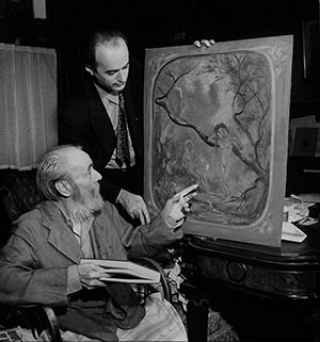Born 1864, Newark, New Jersey
Died 1941, New York City
Born into a wealthy family, Eilshemius received a prestigious education and upbringing. When he was eleven, his parents enrolled him and his brother in a school in Geneva, Switzerland, after which he continued his studies in Dresden, Germany. On graduating in 1881, he returned to the States and attended Cornell University from 1882 through 1884. Although Eilshemius received some art training in his youth, his formative education came through the Art Students League of New York and, in 1886, through the Académie Julian in Paris.
Eilshemius’s early artistic style was rooted in lessons he gleaned from his studies abroad, specifically the landscape aesthetics of the Barbizon School and French impressionism. By 1911, disconcerted by the lack of attention his paintings attracted, he had renounced his formal training and transitioned to an entirely self-conscious and seemingly self-taught style. The Dream shows the influence of American romantic painter Albert Pinkham Ryder, with its loose, free application of paint, suspending the scene somewhere between naturalistic observation and fantasy. Also around this time Eilshemius began to introduce idiosyncratic female nudes into unruly natural settings within illusionistic frames. The nymphs in his Untitled (Night Allegory), for instance, stare out from the bend of a river, engaging the viewer in ambiguous ways.
In 1917 Eilshemius was invited to display his theatrical works at the Society of Independent Artists’ annual exhibition, where they aroused the attention of Marcel Duchamp. In 1920 and 1924, aided by collector and art educator Katherine S. Dreier, Duchamp organized two solo exhibitions of Eilshemius’s work at the Société Anonyme (which he and Dreier had cofounded). Although generally not interested in self-taught art, Duchamp and Dreier gave vociferous support to Eilshemius’s art, which brought him national recognition. As a result, vanguard artists and critics soon rallied around the impoverished and ailing artist, and major collectors such as Duncan Phillips began to acquire his work in the late 1920s.
Nicholas Miller
Banz, Stefan. Louis Michel Eilshemius: Peer of Poet-Painters. Zurich: JR P / R ingier, 2015.
König, Kasper, ed. The Shadow of the AvantGarde: Rousseau and the Forgotten Masters. Berlin: Hatje Cantz, 2015.
